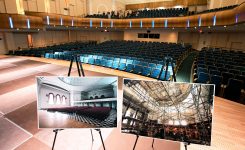Arts & Humanities, Global
The Duke Kunshan Experience
By Eric Ferreri
In creating its new campus in Kunshan, China, Duke University
had the rare opportunity to build a new faculty and curriculum
from scratch. Here’s how they did it.
“We’re imagining a new university in a new country in a new century, and we can take what’s worked in the past and pair it with what’s best for the future.”
-Noah Pickus, associate provost, Duke University, and dean of undergraduate curricular affairs and faculty development, Duke Kunshan University
Noah Pickus
James Miller
Did you hear the one about the religion scholar, the mathematician, the cultural anthropologist and the historian?
James Miller has. He’s the religion scholar, and as part of the interview process for a new faculty position at Duke Kunshan University, he was paired with applicants from those other disciplines. Their task: Design a new, interdisciplinary major for Duke Kunshan’s new undergraduate curriculum.
Here’s the punchline: The group had one hour to do it.
“Could we negotiate all those differences to produce something from the group? This was obviously an exercise no one person could undertake,” Miller recalled recently. “You needed intellectual aptitude and soft skills—people who could work with each other.”
After 60 minutes, the group proposed a fashion technology program that touches on creative design as well as materials, business and manufacturing.
This hypothetical exercise, unusual by the traditional hiring standards in Western higher education, is a snapshot of what Duke is building at its new campus in Kunshan: A mix of scholars from varying backgrounds and areas of expertise who must be flexible, nimble and forward-thinking as they create a suite of new courses for undergraduates who begin classes this fall.
Miller is one of 22 new scholars Duke has hired for its undergraduate venture at Duke Kunshan, the first wave of a hiring spree expected to eventually approach 120 full-time faculty members. Visiting faculty from Duke and other universities will round out the teaching corps. About 225 new undergrads are expected to enroll this fall in Kunshan; eventually, each first-year class there will number roughly 500.
By the Numbers
NEW DUKE KUNSHAN SCHOLARS
22
EXPECTED CLASS SIZE IN FUTURE YEARS
500
EXPECTED FULL TIME FACULTY
120
EXPECTED UNDERGRADS THIS FALL
225
These new scholars are in an unusual position. They face a largely blank academic slate, no history or precedent to weigh them down as they create new courses that will look little like the usual courses at an American university. They’ll do it together, with Duke insisting they step outside their academic comfort zones at times.
Miller, for example, is one of four new faculty members designing an introductory course called China in the World. It will focus on three key themes—science, commerce and conflict—none of which appear to fall squarely within his focus area as a scholar of Chinese religions.
“We’re not trying only to hire individual faculty to teach individual courses in traditionally defined majors and hope students get an integrated education,” said Noah Pickus, a public policy professor and associate provost at Duke who is leading the Duke Kunshan curriculum and faculty hiring process. “We’ve designed a curriculum completely integrated throughout, and the faculty need to understand its logic, work well with each other, and fit their individual contributions into a larger whole.”
“We’ve designed a curriculum completely integrated
throughout, and the faculty need to understand its logic,
work well with each other, and fit their individual
contributions into a larger whole.”
-Noah Pickus
Consider Duke Kunshan’s plan for chemistry, biology and physics. Most American universities teach those separately: Chem 101 anyone? At Duke Kunshan, students on a math or natural sciences track will take seven courses over two years, four of which will have chemistry, biology and physics instruction woven into them.
“We usually teach science in a way that nobody actually practices it today,” Pickus said. “We teach it in silos. You learn physics and you learn chemistry and you learn biology, and then you’re supposed to pick one (as a major) and stick with it.”
But in the real world, Pickus noted, scientists integrate those disciplines—in material science or global health or environmental studies—tapping a vast well of knowledge.
So at Duke Kunshan, the faculty and curriculum are divided into broad areas of expertise – natural sciences, social sciences and arts and humanities, rather than traditional majors or departments. Students can choose integrated majors within one of those divisions or that combine two or more of them.
“We want the faculty to figure out a much harder task of how to teach all this foundational knowledge as an integrated set of knowledge and tools rather than a set of silos where, by the first semester, you’re one category or another,” he said.
Pickus and others see this new undergraduate program less as a university exercise and more as something a Silicon Valley start-up might undertake. Each scholar’s hard skills—intellectual mastery in an academic area—is important, of course. But so are myriad ‘soft’ skills and a willingness to embrace something new and somewhat unknown.
“But the key problems the world faces at the moment can
only be solved by people working across cultural differences,
and across science and the humanities.”
-James Miller
“We have a ‘no jerk’ rule,” Pickus said. “We have the luxury of choosing people who are not only promising scholars and terrific teachers, but who find appealing the idea that they’re taking on something bigger than themselves. We’re looking for people who aren’t primarily focused on benefits packages and teaching loads.”
Miller, the religion scholar, was drawn to this new paradigm, one he says he hasn’t seen before. The author of six scholarly books, Miller comes to Duke Kunshan from Queens University in Ontario, Canada, where he has directed the School of Religion.
“This will be different for me,” he said. “But the key problems the world faces at the moment can only be solved by people working across cultural differences, and across science and the humanities. We need people to work together. At a top school like Duke, we’re training the habits for people who may hold influential positions in whatever fields they choose. So as teachers, we have to model those habits we think are important.”
Yu Wang
Yu Wang knew Duke Kunshan would be different as soon as the interviewing process began. A newly minted Ph.D. in sociology from the University of Wisconsin, Wang interviewed at Duke Kunshan and other, more traditional American universities as well.
“In other job interviews, you never meet all the other candidates,” said Wang, who joins the Duke Kunshan faculty as an assistant professor of social science. “They are rumors. They are secret. You don’t know who they are. For this one, wow! You suddenly meet people from your own discipline and others. It’s really unusual.”
Wang, who grew up in China, is now designing an introductory research methods course that she will co-teach with a cultural anthropologist. She’ll handle the quantitative methods, while her teaching partner will take the qualitative side. But it’s far more complex than just layering one thing upon another. Everything needs to mesh seamlessly.
At Duke Kunshan, 90% of undergrad classes have fewer than 20 students.
To that end, all new Duke Kunshan faculty this spring are honing their teaching techniques through fellowships that allow them to tap into expertise from Duke Learning Innovation, a campus resource to help faculty improve their teaching.
It matters because Duke Kunshan won’t have a traditional class schedule either. Students there will take two classes at a time for seven weeks each; By comparison, Duke students in Durham take four or five classes at a time for 14 weeks each. The Duke Kunshan classes will meet for twice the usual time each week and all classes will have fewer than 20 students.
The format allows for a deep, rather than broad, immersion into a topic and forces faculty members to teach more creatively, Pickus said.
Like everything else, this format is possible because there’s no red tape, no weighty precedent, no ‘this is how we always do things’ looming over the Duke Kunshan experience.
“This is a rare opportunity because you almost never create an institution from scratch anymore,” Pickus said. “Universities are among the oldest institutions in the world, and they’re very stable. But because they’re so stable, it makes it very hard to innovate in other than incremental ways. We’re imagining a new university in a new country in a new century, and we can take what’s worked in the past and pair it with what’s best for the future.”
At Duke Kunshan, the faculty and curriculum are divided into broad areas of knowledge – natural sciences,
social sciences and arts and humanities, rather than traditional majors or departments. Students can
choose integrated majors within one of those divisions or that combine two or more of them.”








